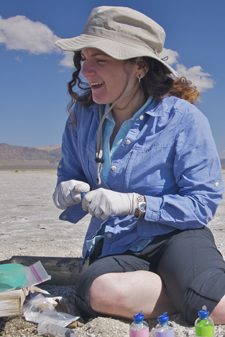 Astrobiology: Arsenic & New Bacteria
Astrobiology: Arsenic & New Bacteria
Quick Summary
NASA Astrobiology Scientist Dr. Felisa Wolfe-Simon (herein referred to as Felisa, per my attempt to make scientists sound like the real people they are) has bred a bacteria that uses arsenic in its molecules instead of phosphorus. So, if people are asking you about NASA’s Big Alien Life Announcement™, that’s it. It’s Earth-life though, not alien life.
Why Is This Cool?
In short, this opens the door for life being “not as we know it” – or at least based on other atoms than all life we have thus far found.
A Short Lesson in Biochemistry
“Carbon, hydrogen, nitrogen, oxygen, phosphorus and sulfur are the six basic building blocks of all known forms of life on Earth.” So – if you’re studying biochemistry you get to play with C, H, N, O, P, and S in as many combinations as you can think of. Sometimes you get to play with others too, but not a lot. This is also most of what makes up your body, though you’ll be able to name a few notable others we have an need (like Iron – Fe), but they’re minor on the scale of how much there is in a lifeform.
Phosphorus is key. So are the others, of course, but for this article we’re discussing P today. Phosphorus is essential in DNA and RNA, and most interesting to me, essential in ATP (bear with me for a second). I personally have no problem with the idea of replacing phosporus in a molecule (like DNA) with some other atom that makes the same number of bonds – like arsenic. Yes it will change the shape, but you can actually do it. Experts in the area DO have a problem.
Here’s what I think is cool: ATP is how a cell stores energy. When you break an ATP molecule (tri-phosphate) into an ADP (di-phosphate) molecule and associate components, you get energy out of that reaction. That’s how chemistry works – some reactions take energy, some give energy. So, it surprises me that when you make AT-Arsenic you’d get a reasonably correct amount of energy to power a cell.
How GFAJ-1 Came To Be
Felisa was studying bacteria at Mono Lake – a lake in Eastern California with fascinating chemistry, including high levels of arsenic. Taking some of these bacteria, already accustomed to living with levels of arsenic (toxic to most life), she exposed successive generations to higher and higher levels of arsenic, replacing the phosphorus in their environment, until eventually the creatively-named GFAJ-1 was living and reproducing without taking in ANY new phosphorus.
This is where other scientists become skeptical, but not so skeptical as to say “no way!”. Just because the bacteria aren’t taking in phosphorus, doesn’t mean they have incorporated the arsenic into their molecules in place of the phosphorus. Felisa says, among many reasoned arguments: wait for the next paper, which she’s already written but hasn’t been published, and you’ll see some stronger evidence supporting that arsenic is being incorporated in place of the phosphorus.
Skeptical?
In true scientific fashion NASA introduced an expert chemist Dr. Steven Benner to, in his own words, “throw a wet blanket on things” and explain why this discovery/claim/finding is so extraordinary – so extraordinary as to need extraordinary proof (as Carl Sagan so famously said). In short, his difficulty is that arsenic formed into arsenate is much much weaker than phosphate, and therefore the DNA chains and other molecules are much more likely to fall apart. This would mean that life would choose phosphate over arsenate, or it would have to adapt significantly to support this weaker molecule.
A Couple Quick Random Interesting Thoughts
- This press conference was dominated by women scientists! Yay!
- I am not a biochemist, and I don’t completely understand what’s at play here, but I have long argued with one of my astronomy professors that Silicon-based life is entirely possible, we don’t have a way to disprove it yet. (Silicon making the same bonds as Carbon). Well, he staunchly and legitimately argues against me, but I think this finding gives my side a LITTLE bit more weight.
- I am struck by the similarity, and yet complete difference, between this and the discovery of life at hydrothermal vents. They too have distinct biochemistry, though their molecules are all normal. They don’t conduct photosynthesis (with a biproduct of oxygen), they conduct chemosynthesis (with a biproduct of sulfur). Noteably they still have a good amount of oxygen in their chemical makeup, it’s their source of energy which is different.
Want More?
My Two Favorite Bits of the NASA Press Conference: Felisa speaking (about 2 minutes in), and Steven explaining what needs to be thought about.
![]()
~ A l i c e !







Sorry to have seen this today: http://www.slate.com/id/2276919
It may be sour grapes or a legitimate question. Will be watching for further news.
Like your site. I’m a female science geek too.
Best, d
although i strongly disapprove of the tone of that article, i definitely think the skepticism is warranted. some similar points were raised in the briefing i think, to which the response was… wait until the next paper, we have already finished the research, it is still in peer review though so we cannot discuss it. i think this second paper will hold the convincing evidence if there is any. i will give felisa the benefit of the doubt until i see that paper, assuming it comes out within a reasonable period of time. sorry about my lack of caps and decent punctuation … i am experiencing significant keyboard malfunction!